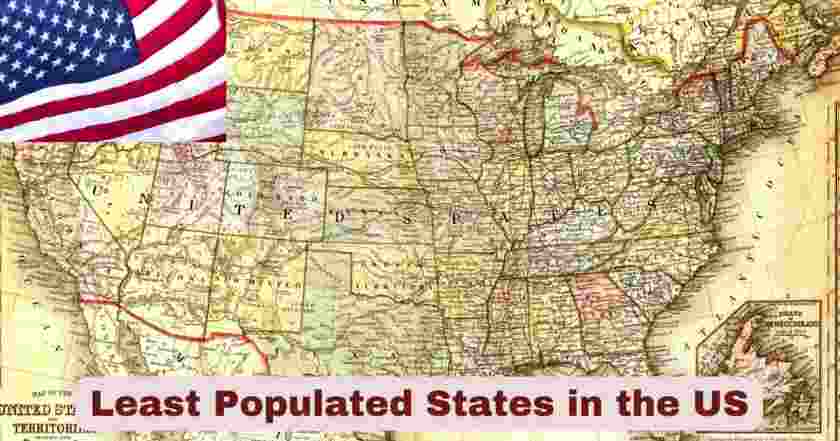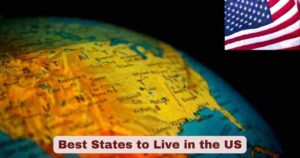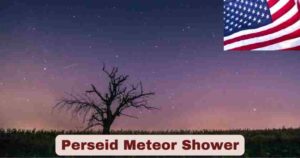Least Populated States in the US 2025
America’s demographic landscape reveals striking contrasts between bustling metropolitan centers and vast rural expanses, with the least populated states in the US 2025 representing unique opportunities for those seeking solitude, natural beauty, and tight-knit communities. Wyoming, Vermont, and Alaska lead this category with populations under 1 million residents each, offering dramatically different lifestyles from their densely populated counterparts. These sparsely populated regions collectively house fewer than 10 million Americans across 25 states, yet encompass vast geographical areas rich in natural resources, agricultural potential, and cultural heritage.
Wyoming stands as America’s least populated state with only 580,000 residents spread across 97,813 square miles, creating a population density of just 6 people per square mile. This extreme sparsity reflects broader demographic trends where Americans concentrate in urban corridors while rural areas face population challenges from economic shifts, aging demographics, and limited employment opportunities. Understanding the least populated states in the US 2025 provides crucial insights into rural America’s struggles and strengths, infrastructure needs, and the unique policy challenges facing these regions in maintaining economic viability while preserving their distinctive character and natural environments.
Interesting Stats & Facts About Least Populated States in the US 2025
| Fact Category | Details |
|---|---|
| Combined Population | 25 least populated states contain less than 50 million people |
| California Comparison | California alone has more residents than the 21 least populated states combined |
| Wyoming’s Density | 6 people per square mile – lower than many countries |
| Vermont’s Uniqueness | Only state with no cities over 50,000 residents |
| Alaska’s Size Paradox | Largest state by area, third smallest by population |
| North Dakota Oil Boom | Population grew 15.8% in last decade due to energy sector |
| Small Town Dominance | Rural populations exceed urban in most least populated states |
| Economic Challenges | Limited job diversity creates outmigration pressure |
| Aging Demographics | Median ages above national average in most small states |
| Political Influence | Equal Senate representation gives outsized federal power |
The statistics reveal fascinating realities about America’s rural-urban divide and demographic distribution patterns. Wyoming’s 580,000 residents occupy territory larger than New England, while Vermont’s 650,000 people maintain the nation’s strongest rural character with no major metropolitan areas. Alaska’s 733,000 residents spread across 663,300 square miles create the ultimate frontier lifestyle, with many communities accessible only by plane or boat, demonstrating how geography shapes population patterns.
These least populated states face unique challenges maintaining essential services, economic growth, and political relevance despite their small populations. North Dakota’s oil boom temporarily reversed decades of population decline, adding over 100,000 residents since 2010, while states like West Virginia and Vermont continue experiencing modest population losses. The demographic realities of small-population states create both opportunities for those seeking affordable living and natural beauty, and challenges for maintaining infrastructure, healthcare systems, and educational institutions across vast rural territories.
Least Populated States in the US
| Rank | State | 2025 Population | Population Change | Density (per sq mi) |
|---|---|---|---|---|
| 1 | Wyoming | 580,000 | +0.8% | 6 |
| 2 | Vermont | 650,000 | -0.03% | 68 |
| 3 | Alaska | 733,406 | +0.4% | 1 |
| 4 | North Dakota | 780,000 | +2.3% | 11 |
| 5 | South Dakota | 900,000 | +1.4% | 12 |
| 6 | Delaware | 1,036,036 | +1.2% | 416 |
| 7 | Rhode Island | 1,100,000 | +0.2% | 712 |
| 8 | Montana | 1,139,449 | +1.8% | 8 |
| 9 | Maine | 1,360,260 | +0.1% | 38 |
| 10 | New Hampshire | 1,395,231 | +0.5% | 149 |
| 11 | Hawaii | 1,420,491 | +0.3% | 130 |
| 12 | West Virginia | 1,800,000 | -0.6% | 74 |
| 13 | Idaho | 1,932,866 | +2.9% | 23 |
| 14 | Nebraska | 1,969,845 | +0.6% | 25 |
| 15 | New Mexico | 2,100,000 | +0.8% | 17 |
| 16 | Mississippi | 2,930,472 | -0.1% | 61 |
| 17 | Kansas | 2,937,880 | +0.2% | 36 |
| 18 | Arkansas | 3,050,334 | +0.3% | 57 |
| 19 | Nevada | 3,100,000 | +1.6% | 28 |
| 20 | Iowa | 3,179,849 | +0.1% | 57 |
| 21 | Utah | 3,500,000 | +1.7% | 41 |
| 22 | Connecticut | 3,640,329 | +0.1% | 657 |
| 23 | Oklahoma | 4,000,000 | +0.5% | 57 |
| 24 | Oregon | 4,300,000 | +1.0% | 44 |
| 25 | Kentucky | 4,569,305 | +0.3% | 113 |
| 26 | Louisiana | 4,628,797 | -0.2% | 88 |
| 27 | Alabama | 5,074,296 | +0.4% | 97 |
| 28 | South Carolina | 5,300,000 | +1.4% | 166 |
| 29 | Minnesota | 5,800,000 | +0.7% | 67 |
| 30 | Wisconsin | 5,900,000 | +0.2% | 90 |
| 31 | Colorado | 5,987,073 | +1.3% | 58 |
| 32 | Maryland | 6,177,224 | +0.6% | 498 |
| 33 | Missouri | 6,200,000 | +0.3% | 89 |
| 34 | Indiana | 6,858,986 | +0.5% | 188 |
| 35 | Tennessee | 7,100,000 | +1.1% | 168 |
| 36 | Massachusetts | 7,200,000 | +0.4% | 682 |
| 37 | Arizona | 7,359,191 | +1.8% | 65 |
| 38 | Washington | 7,900,000 | +1.5% | 111 |
| 39 | Virginia | 8,600,000 | +0.8% | 201 |
| 40 | New Jersey | 9,300,000 | +0.3% | 1,066 |
| 41 | Michigan | 10,034,113 | +0.1% | 104 |
| 42 | North Carolina | 10,800,000 | +1.3% | 201 |
| 43 | Georgia | 11,021,634 | +1.2% | 186 |
| 44 | Ohio | 11,760,000 | +0.2% | 262 |
| 45 | Illinois | 12,569,321 | -0.3% | 217 |
| 46 | Pennsylvania | 13,079,000 | +0.1% | 284 |
| 47 | New York | 19,867,000 | -0.2% | 364 |
| 48 | Florida | 23,372,000 | +2.0% | 356 |
| 49 | Texas | 31,291,000 | +1.34% | 117 |
| 50 | California | 39,431,000 | +0.57% | 241 |
Wyoming maintains its position as America’s least populated state with just 580,000 residents spread across vast ranching and energy territories, offering unparalleled outdoor recreation and frontier lifestyle opportunities despite economic challenges from commodity price fluctuations.
Vermont ranks as the second least populated state with 650,000 residents experiencing slight population decline, though the Green Mountain State maintains strong tourism, agriculture, and manufacturing sectors while preserving its distinctive rural character.
Alaska occupies third position among least populated states with 733,406 residents across America’s largest territory, creating unique lifestyle opportunities in pristine wilderness settings despite harsh climate conditions and high living costs.
North Dakota shows remarkable growth as the fourth least populated state with 780,000 residents and impressive 2.3% annual growth driven by oil boom economics in western regions, transforming traditional agricultural economy.
South Dakota rounds out the five least populated states with 900,000 residents and healthy 1.4% growth supported by tourism, agriculture, and business-friendly policies attracting new residents and enterprises to the Mount Rushmore State.
Delaware ranks sixth among small population states with 1.0 million residents packed into the nation’s second-smallest territory, creating unique blend of rural character and urban proximity to major East Coast markets.
Rhode Island holds seventh position with 1.1 million residents in America’s smallest state, demonstrating how geographic constraints can support higher population density while maintaining distinct regional identity and economic opportunities.
Montana occupies eighth place with 1.1 million residents experiencing strong 1.8% growth across Big Sky Country, attracting newcomers seeking outdoor recreation, energy sector employment, and rural lifestyle opportunities.
Maine ranks ninth among least populated states with 1.4 million residents maintaining steady population through tourism, fishing industries, and coastal appeal despite economic challenges from geographic isolation.
New Hampshire holds tenth position with 1.4 million residents benefiting from proximity to Boston markets and tax advantages while preserving rural character and outdoor recreation opportunities throughout the Granite State.
Hawaii occupies eleventh place with 1.4 million residents spread across Pacific islands, creating unique demographic patterns influenced by geography, tourism industry, and military presence in America’s most isolated state.
West Virginia ranks twelfth with 1.8 million residents but experiences -0.6% population decline due to coal industry challenges and limited economic diversification, though natural beauty attracts outdoor recreation and retirement populations.
Idaho holds thirteenth position with 1.9 million residents and exceptional 2.9% growth rate leading all small population states, driven by technology sector expansion, outdoor recreation appeal, and affordable living costs.
Nebraska occupies fourteenth place with 2.0 million residents and steady 0.6% growth supported by agricultural economy, renewable energy development, and strategic central location attracting logistics and manufacturing operations.
New Mexico ranks fifteenth among smaller states with 2.1 million residents and 0.8% growth driven by energy sector development, aerospace industries, and cultural tourism in the Land of Enchantment.
Mississippi holds sixteenth position with 2.9 million residents experiencing slight -0.1% decline due to economic challenges, though agricultural strength and manufacturing growth provide stability for the Magnolia State.
Kansas occupies seventeenth place with 2.9 million residents and modest 0.2% growth supported by agricultural leadership, aerospace manufacturing, and central location advantages for transportation and logistics industries.
Arkansas ranks eighteenth with 3.1 million residents and minimal 0.3% growth through agricultural economy, manufacturing expansion, and affordable living costs supporting population stability in the Natural State.
Nevada holds nineteenth position with 3.1 million residents and impressive 1.6% growth driven by tourism industry, mining sector, and tax advantages attracting businesses and retirees to the Silver State.
Iowa occupies twentieth place with 3.2 million residents and steady 0.1% growth supported by agricultural leadership, renewable energy development, and educational excellence attracting families and young professionals.
Utah ranks twenty-first with 3.5 million residents and strong 1.7% growth fueled by technology sector expansion, outdoor recreation industry, and young demographics creating economic dynamism in the Beehive State.
Connecticut holds twenty-second position with 3.6 million residents and minimal 0.1% growth despite high living costs, benefiting from proximity to New York City and strong financial services sector.
Oklahoma occupies twenty-third place with 4.0 million residents and moderate 0.5% growth supported by energy sector diversification, aerospace manufacturing, and agricultural strength throughout the Sooner State.
Oregon ranks twenty-fourth with 4.3 million residents and healthy 1.0% growth driven by technology sector development, outdoor recreation industry, and progressive policies attracting diverse populations to the Pacific Northwest.
Kentucky holds twenty-fifth position with 4.6 million residents and minimal 0.3% growth through bourbon industry, coal mining heritage, and agricultural traditions supporting steady population levels in the Bluegrass State.
The comprehensive ranking reveals dramatic population disparities even among smaller states, with California’s 39.4 million residents representing 68 times more people than Wyoming’s 580,000. Geographic size doesn’t correlate with population, as Alaska’s massive 663,300 square miles supports fewer residents than Delaware’s tiny 2,489 square miles.
Regional economic factors significantly influence population patterns among least populated states, with energy-producing regions like North Dakota and Wyoming experiencing growth despite harsh climates, while traditional manufacturing areas face population challenges from economic transformation and outmigration to warmer, more economically diverse regions.
Fastest Declining Population States in the US 2025
| State | Population Loss Rate | Net Migration | Economic Factor | Primary Challenge |
|---|---|---|---|---|
| West Virginia | -0.6% | -12,000 | Coal Industry Decline | Economic Diversification |
| Illinois | -0.3% | -87,000 | High Taxes | Business Retention |
| New York | -0.2% | -102,000 | High Living Costs | Affordability Crisis |
| Louisiana | -0.2% | -8,000 | Hurricane Impact | Climate Resilience |
| Mississippi | -0.1% | -3,000 | Limited Opportunities | Economic Development |
| Vermont | -0.03% | -200 | Aging Population | Youth Retention |
| Connecticut | +0.1% | -5,000 | Tax Burden | Competitive Positioning |
| Maine | +0.1% | -1,000 | Geographic Isolation | Economic Connectivity |
| Iowa | +0.1% | -2,000 | Rural Economy | Urban Development |
| Pennsylvania | +0.1% | -8,000 | Rust Belt Legacy | Innovation Economy |
West Virginia leads population decline among small states at -0.6% annually, losing 12,000 residents as coal industry challenges force workers to relocate to states with more diverse economic opportunities and higher-paying employment prospects.
Illinois experiences significant outmigration despite large population base, losing 87,000 residents annually due to high tax burdens and business-unfriendly policies that drive both individuals and companies to more competitive neighboring states with lower costs and regulatory environments.
Regional Distribution of Least Populated States in the US 2025
| Region | Small States Count | Combined Population | Average Density | Economic Characteristics |
|---|---|---|---|---|
| Mountain West | 8 States | 12.2 million | 18 per sq mi | Energy, Mining, Tourism |
| Great Plains | 6 States | 9.8 million | 22 per sq mi | Agriculture, Energy |
| New England | 4 States | 8.4 million | 156 per sq mi | Technology, Finance |
| Upper Midwest | 3 States | 7.1 million | 43 per sq mi | Agriculture, Manufacturing |
| Southeast | 4 States | 13.8 million | 78 per sq mi | Agriculture, Energy |
The Mountain West contains the most sparsely populated states with 8 states averaging just 18 people per square mile, reflecting challenging terrain, harsh climates, and resource-based economies that support small populations across vast territories rich in minerals and natural beauty.
Great Plains states demonstrate the agricultural heartland’s demographic reality, with 6 states supporting 9.8 million residents through farming, ranching, and energy production, though mechanization and economic consolidation continue pressuring rural population levels throughout America’s breadbasket region.
Economic Challenges in Least Populated States in the US 2025
| Challenge Category | Affected States | Economic Impact | Population Effect | Policy Response |
|---|---|---|---|---|
| Brain Drain | Wyoming, N. Dakota, Alaska | -$2.1 billion GDP | Youth Outmigration | Education Incentives |
| Limited Job Diversity | Vermont, Montana, Maine | Wage Stagnation | Career Limitations | Economic Development |
| Infrastructure Costs | Alaska, Wyoming, Montana | High Per Capita | Service Delivery | Federal Investment |
| Healthcare Access | Rural All States | Provider Shortages | Quality of Life | Telemedicine Expansion |
| Aging Demographics | Vermont, Maine, W. Virginia | Labor Shortages | Dependency Ratios | Immigration Policies |
Brain drain affects most least populated states as young college graduates relocate to metropolitan areas offering diverse career opportunities, higher salaries, and urban amenities, creating cycles of economic stagnation and demographic aging in rural communities.
Limited economic diversification in many small population states creates vulnerability to commodity price fluctuations, industry consolidation, and technological disruption, making these regions heavily dependent on agriculture, energy, and natural resource extraction that offer fewer high-skilled employment opportunities.
Rural Development Opportunities in Least Populated States in the US 2025
| Development Sector | Leading States | Investment Potential | Job Creation | Growth Driver |
|---|---|---|---|---|
| Remote Work | Vermont, Montana, Idaho | $890 million | 34,000 jobs | Digital Infrastructure |
| Renewable Energy | Wyoming, N. Dakota, Kansas | $2.3 billion | 18,000 jobs | Wind/Solar Development |
| Outdoor Recreation | Montana, Alaska, Maine | $1.2 billion | 28,000 jobs | Tourism Growth |
| Agricultural Technology | Iowa, Nebraska, S. Dakota | $650 million | 12,000 jobs | Precision Farming |
| Value-Added Manufacturing | Arkansas, Mississippi, Kentucky | $1.8 billion | 45,000 jobs | Supply Chain Shifts |
Remote work revolution creates unprecedented opportunities for least populated states to attract educated professionals seeking affordable living, outdoor recreation, and rural lifestyle benefits while maintaining urban-level employment through digital connectivity and flexible work arrangements.
Renewable energy development offers economic transformation potential for energy-rich small states, with wind and solar projects generating construction jobs, tax revenues, and long-term employment opportunities while diversifying economies beyond traditional fossil fuel dependence and creating sustainable growth pathways.
Quality of Life in Least Populated States in the US 2025
| Life Quality Factor | Top Performing States | National Ranking | Resident Benefits | Attraction Factor |
|---|---|---|---|---|
| Low Crime Rates | Vermont, Maine, N. Hampshire | Top 5 | Safe Communities | Family Appeal |
| Natural Beauty | Alaska, Montana, Wyoming | Unmatched | Outdoor Access | Recreation Lifestyle |
| Affordable Housing | Iowa, Kansas, Arkansas | Top 15 | Homeownership | Economic Opportunity |
| Community Connection | Small Towns Nationwide | Strong Social Bonds | Neighborly Support | Cultural Preservation |
| Environmental Quality | Mountain West States | Clean Air/Water | Health Benefits | Sustainability |
Vermont consistently ranks among America’s safest states with violent crime rates 60% below national average, creating family-friendly environments where children can explore freely and communities maintain strong social cohesion through shared values and mutual support.
Natural beauty in least populated states provides unparalleled access to pristine wilderness, outdoor recreation opportunities, and environmental quality that urban areas cannot match, attracting residents seeking active lifestyles and connection to nature’s rhythms and seasonal cycles.
Transportation and Connectivity in Least Populated States in the US 2025
| State | Highway Miles | Public Transit | Airport Access | Broadband Coverage | Connectivity Score |
|---|---|---|---|---|---|
| Wyoming | 6,408 | Limited | Regional | 78% | C- |
| Vermont | 2,848 | Rural Routes | Limited | 85% | C+ |
| Alaska | 5,018 | Urban Only | Essential | 68% | C- |
| North Dakota | 8,563 | Minimal | Regional | 82% | C |
| South Dakota | 8,460 | Limited | Tourism | 79% | C |
| Montana | 10,324 | Minimal | Regional | 74% | C- |
| Maine | 8,128 | Coastal | Seasonal | 88% | B- |
| Idaho | 5,045 | Urban | Regional | 81% | C+ |
| New Hampshire | 4,154 | Commuter | Limited | 89% | B |
| Delaware | 6,373 | Regional | Major Nearby | 91% | B+ |
Transportation infrastructure in least populated states faces unique challenges serving small populations across vast territories, requiring substantial per-capita investment to maintain essential connectivity while many rural areas lack public transit options forcing residents to depend on personal vehicles.
Broadband connectivity varies dramatically among small population states, with New Hampshire at 89% coverage compared to Alaska’s 68%, creating digital divides that limit remote work opportunities, educational access, and economic development potential in isolated rural communities.
Healthcare Systems in Least Populated States in the US 2025
| State | Hospitals per 100k | Physicians per 100k | Rural Health Ranking | Access Challenges | Telemedicine Usage |
|---|---|---|---|---|---|
| Wyoming | 2.1 | 189 | #43 | Provider Shortages | High |
| Vermont | 3.4 | 398 | #12 | Specialist Access | Moderate |
| Alaska | 1.8 | 267 | #31 | Geographic Barriers | Very High |
| North Dakota | 4.2 | 298 | #19 | Travel Distances | High |
| Montana | 3.1 | 234 | #35 | Critical Access | High |
| Maine | 2.9 | 356 | #18 | Rural Coverage | Moderate |
| South Dakota | 4.8 | 267 | #28 | Specialist Shortages | High |
| Idaho | 2.3 | 201 | #39 | Growth Strain | Moderate |
| New Hampshire | 2.7 | 389 | #11 | Cost Pressures | Low |
| West Virginia | 3.2 | 223 | #46 | Population Health | Moderate |
Rural healthcare in least populated states faces severe challenges from physician shortages, with states like Wyoming having only 189 doctors per 100,000 residents compared to urban areas with over 400 per 100,000, forcing patients to travel hundreds of miles for specialized care.
Telemedicine adoption reaches highest levels in geographically isolated states like Alaska and Wyoming, where remote consultations bridge gaps in specialist access and emergency care, though broadband limitations still constrain service delivery in many rural communities throughout small population states.
Future Outlook
Demographic projections suggest least populated states in the US 2025 will face continued challenges through 2035 as urbanization trends accelerate and climate change impacts rural communities, though some regions may benefit from remote work adoption and climate migration from overheated metropolitan areas. Technology sector expansion, renewable energy development, and outdoor recreation industries could provide economic lifelines for states willing to invest in digital infrastructure and quality of life improvements that attract knowledge workers seeking affordable alternatives to expensive coastal markets.
The long-term viability of America’s least populated states depends on successful adaptation to 21st-century economic realities including automation in agriculture, energy transition challenges, and changing demographic preferences among younger generations. States that embrace innovation, environmental stewardship, and community development while maintaining their unique cultural identities and natural beauty advantages will be best positioned to reverse population decline trends and create sustainable prosperity for rural communities in an increasingly connected but geographically dispersed economy.
Disclaimer: The data research report we present here is based on information found from various sources. We are not liable for any financial loss, errors, or damages of any kind that may result from the use of the information herein. We acknowledge that though we try to report accurately, we cannot verify the absolute facts of everything that has been represented.







